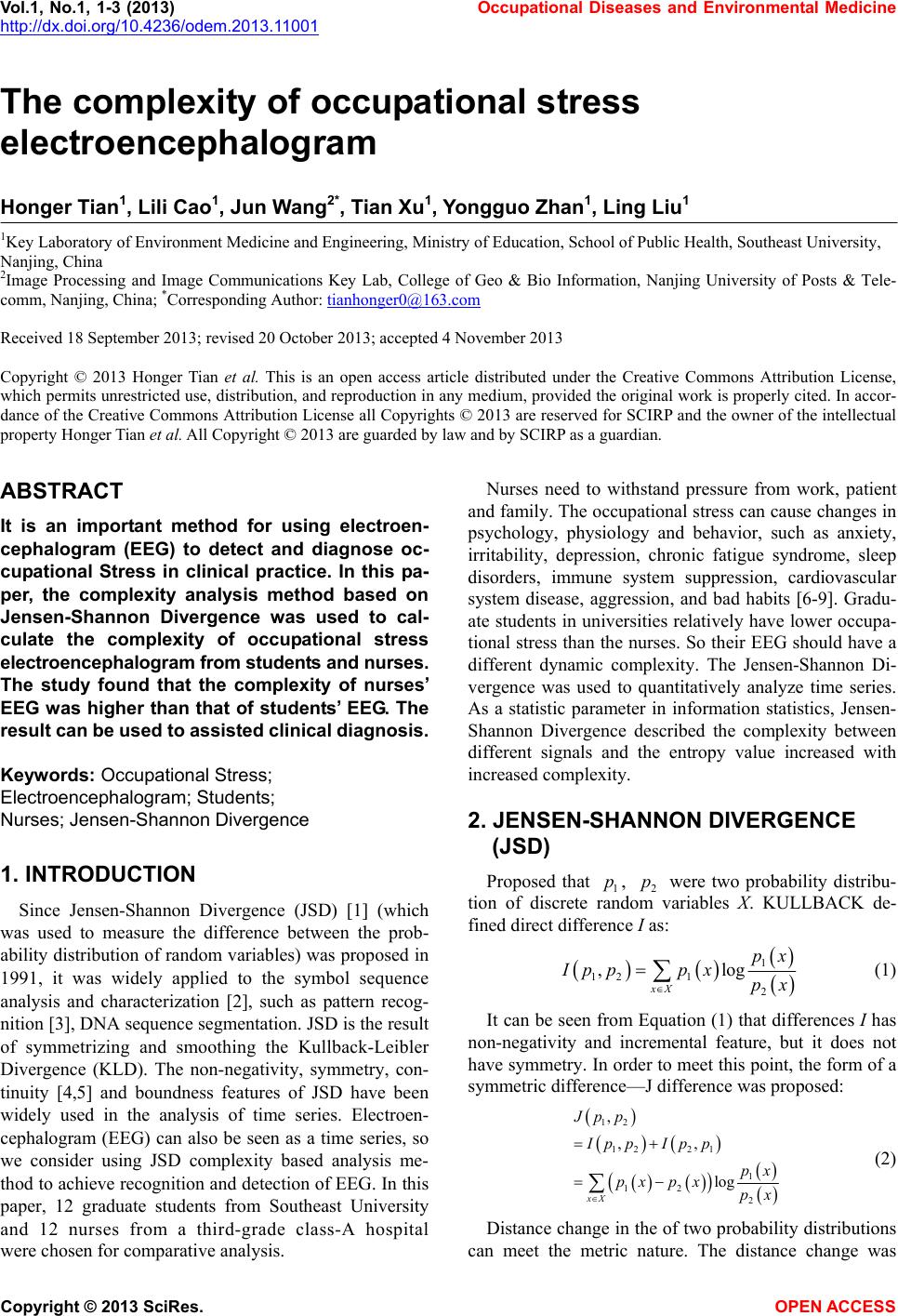
Vol.1, No.1, 1-3 (2013) Occupational Diseases and Environmental Medicine
http://dx.doi.org/10.4236/odem.2013.11001
The complexity of occupational stress
electroencephalogram
Honger Tian1, Lili Cao1, Jun Wang2*, Tian Xu1, Yongguo Zhan1, Ling Liu1
1Key Laboratory of Environment Medicine and Engineering, Ministry of Education, School of Public Health, Southeast University,
Nanjing, China
2Image Processing and Image Communications Key Lab, College of Geo & Bio Information, Nanjing University of Posts & Tele-
comm, Nanjing, China; *Corresponding Author: tianhonger0@163.com
Received 18 September 2013; revised 20 October 2013; accepted 4 November 2013
Copyright © 2013 Honger Tian et al. This is an open access article distributed under the Creative Commons Attribution License,
which permits unrestricted use, distribution, and reproduction in any medium, provided the original work is properly cited. In accor-
dance of the Creative Commons Attribution License all Copyrights © 2013 are reserved for SCIRP and the owner of the intellectual
property Honger Tian et al. All Copyright © 2013 are guarded by law and by SCIRP as a guardian.
ABSTRACT
It is an important method for using electroen-
cephalogram (EEG) to detect and diagnose oc-
cupational Stress in clinical practice. In this pa-
per, the complexity analysis method based on
Jensen-Shannon Divergence was used to cal-
culate the complexity of occupational stress
electroencephalogram from students and nurses.
The study found that the complexity of nurses’
EEG was higher than that of students’ EEG. The
result can be used to assisted clinical diagnosis.
Keywords: Occupational Stress;
Electroencephalogram; Student s;
Nurses; Jensen-Shannon Divergence
1. INTRODUCTION
Since Jensen-Shannon Divergence (JSD) [1] (which
was used to measure the difference between the prob-
ability distribution of random variables) was proposed in
1991, it was widely applied to the symbol sequence
analysis and characterization [2], such as pattern recog-
nition [3], DNA sequence segmentation. JSD is the result
of symmetrizing and smoothing the Kullback-Leibler
Divergence (KLD). The non-negativity, symmetry, con-
tinuity [4,5] and boundness features of JSD have been
widely used in the analysis of time series. Electroen-
cephalogram (EEG) can also be seen as a time series, so
we consider using JSD complexity based analysis me-
thod to achieve recognition and detection of EEG. In this
paper, 12 graduate students from Southeast University
and 12 nurses from a third-grade class-A hospital
were chosen for comparative analysis.
Nurses need to withstand pressure from work, patient
and family. The occupational stress can cause changes in
psychology, physiology and behavior, such as anxiety,
irritability, depression, chronic fatigue syndrome, sleep
disorders, immune system suppression, cardiovascular
system disease, aggression, and bad habits [6-9]. Gradu-
ate students in universities relatively have lower occupa-
tional stress than the nurses. So their EEG should have a
different dynamic complexity. The Jensen-Shannon Di-
vergence was used to quantitatively analyze time series.
As a statistic parameter in information statistics, Jensen-
Shannon Divergence described the complexity between
different signals and the entropy value increased with
increased complexity.
2. JENSEN-SHANNON DIVERGENCE
(JSD)
Proposed that 1, 2 were two probability distribu-
tion of discrete random variables X. KULLBACK de-
fined direct difference I as:
p p
1
12 1
2
,log
xX
px
Ipppx px
(1)
It can be seen from Equation (1) that differences I has
non-negativity and incremental feature, but it does not
have symmetry. In order to meet this point, the form of a
symmetric difference—J difference was proposed:
12
12 21
1
12
2
,
,,
log
xX
Jpp
Ipp Ipp
px
px pxpx
(2)
Distance change in the of two probability distributions
can meet the metric nature. The distance change was
Copyright © 2013 SciRes. OPEN A CCESS